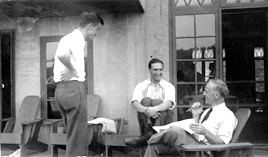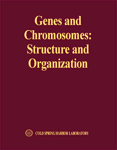|
IX: Genes and Chromosomes: Structure and Organization 1941 |
|
|

|
From left: Dr. Max Delbruck, Dr. Salvador Luria, and Dr. F. Exner SYMPOSIUM SYNOPSIS LIST OF PARTICIPANTS CONTENTS OF SYMPOSIUM VOLUME PHOTOGRAPHS PUBLISHED VOLUME  |
Genes and Chromosomes: Structure and Organization
18 June–2 July, 1941
Symposium Synopsis
Organizer: Milislav Demerec
Just as Eric Ponder had chosen his own field of research for the topic of his last Symposium, so Demerec did the same for his first Symposium. But although the title of the 1941 Symposium suggests that Demerec had broken with the biophysical emphasis of the earlier Symposia, the studies reported in this meeting relied heavily on biophysical approaches and techniques. It was only with the 1946 Symposium on Heredity and Variation in Microorganisms that genetics became the theme that was to dominate the Symposia for the next two decades.
Demerec came to the Carnegie Institution's Department of Genetics at Cold Spring Harbor in 1923 to work on unstable loci in Drosophila, and later on he used X-rays to induce mutations. He justified his choice of the Symposium topic on the grounds that mathematics, chemistry and physics all played an important role in the studies of genes and chromosomes—mathematics is used by geneticists to analyse their data; chemical analysis is used to determine the constituents of genes and chromosomes; and physical techniques were being used to examine the structure of chromosomes.
There are several intriguing facts associated with this Symposium. It was Barbara McClintock's first visit to Cold Spring Harbor and she described the breakage-fusion-bridge cycle in maize chromosomes; she would join the Department of Genetics in 1942. Salvador Luria and Max Delbruck were there, and they stayed for summer to work together for the first time—this led, after the war, to the Phage Course and to the Laboratory becoming the headquarters of the Phage Group.
H. J. Muller's declaration in his summing-up—"The time has come when a few...of the physicists and biochemists realize that genes and chromosomes do form valid subjects of inquiry, and that what the biologists have been saying about their mysterious properties calls for some more looking into on their part"—would be fulfilled many times over in the post-war years.
One of Demerec's first changes to the Symposium format was to have it last only two weeks instead of the customary five! This may have contributed to the increased number of participants to 120—about double the usual number. Demerec remarked in the Annual Report that the Symposium volume was selling well and had been adopted by some as an advanced textbook.
Search images: